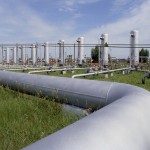Natural gas reversed daily movement on Thursday after the Energy Information Administration reported a smaller-than-expected inventory decline last week. However, gains were capped as cold weather across the eastern and northern US induced significantly stronger heating demand.
Natural gas for delivery in March traded 1.18% lower at $2.764 per million British thermal units at 15:34 GMT, shortly after it fell to a session low of $2.736. The contract rose 4.48% yesterday to $2.797 and is up 7.1% for the week so far.
The Energy Information Administration said in its weekly report that US natural gas stockpiles fell by 160 billion cubic feet in the week ended February 6th, well beneath analysts expectations for a decline in the range of 165-175 bcf and also below the five-year average draw of 178 bcf. Stockpiles slid by 234 bcf during the comparable week a year earlier.
Total gas held in US storage hubs amounted to 2.268 trillion cubic feet, narrowing the deficit to the five-year average of 2.279 trillion to 0.5% from 1.2% a week earlier. The surplus to the year-ago storage of 1.726 trillion cubic feet expanded to 31.4% from 23.9% during the preceding period.
Inventories in the East Region fell by 113 bcf to 1.081 trillion and were 2.9% below the average, while stockpiles in the West were unchanged at 371 bcf, posting an 11.4% surplus. The Producing Region received a net withdrawal of 47 bcf to 816 bcf, bringing supplies to 2.0% beneath the average.
Despite the bearish report, however, movement to the downside remained limited as forecasting agencies called for colder-than-usual weather across large parts of the US.
According to NatGasWeather.com, natural gas demand in the US will be high compared to normal through February 18th, with mild conditions set to dominate the West over the next seven days, while the central US turns cooler and the East remains cold.
Colder-than-usual readings over the eastern and northern US continue to spur significantly stronger heating demand, especially as overnight lows across the Great Lakes and Northeast drop into the single digits and below zero. An even stronger cold blast with heavier snowfall is anticipated to follow on Saturday, extending below-freezing temperatures deep into the Southeast and spurring locally high heating demand. The West will continue to enjoy dry and warm conditions this weekend that will spread into the central US, with temperatures across Texas and California set to peak in the 70s and 80s.
Early next week, a weather system will bring showers across Texas and the southern Plains before a cold blast hits the northern US on Tuesday and Wednesday and pushes into the central US, including Texas.
Weather systems will continue to bring showers and colder-than-usual readings to the Midwest into the East in the course of the week, while the central US experiences a few cold blasts. The most threatening truly cold air, however, will remain confined to the Great Lakes and Northeast, while the West remains near or warmer than usual.




